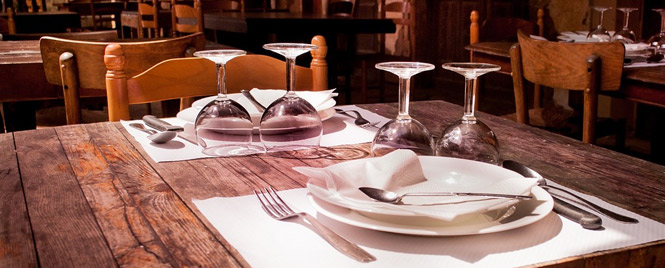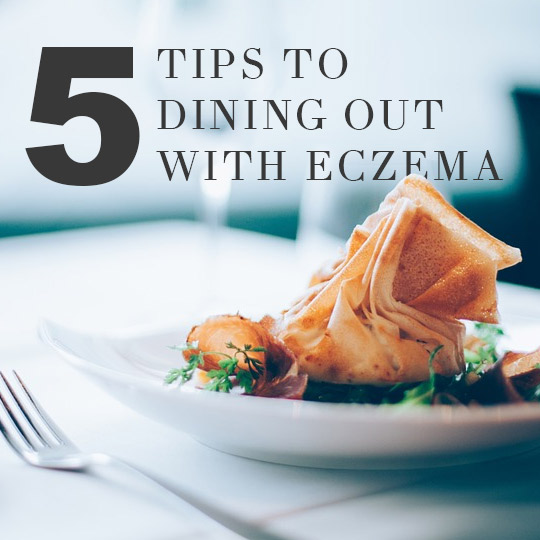5 Tips to Dining Out With Eczema
Dining out should be the event you deserve. The goal is to enjoy the company of friends and family whom you love and enjoy sharing laughs with while you break the proverbial bread together. This is the epitome of what dining out should be.
However, this carefree way of spending your free time doesn’t come so easily for many people struggling with inflammation, and when you’re living in a body which responds to tacos the same way the Hulk responds to a bar fight, then things need to be a bit better planned out.
I don’t claim to be a miracle worker, and I certainly can’t tell you how to Rumpelstiltskin your way into perfect skin by eating cheeseburgers. But what I can do is give you a few helpful tips to keep in mind for when cheap-lunch-Tuesday rolls around.
Yes, some people are more affected by what they eat than others, and for some, how they react to food can actually fluctuate. One thing’s for sure, and that is understanding the big culprits commonly linked to inflammation in the body can be the difference between happy-skin, and a world of itch.
That said, I’m a firm believer in continuously flooding the body with surplus clean, and highly nutritious foods to ensure the occasional slip is better handled by the body.
Although I realize there are other aspects to social gatherings which are important, which is why I covered them in my article ‘How to party with eczema.’ This article will focus purely on the food aspect of dining out with eczema.
Today I will cover the following:
![]() Become the organizer
Become the organizer![]()
![]()
![]()
![]()
![]()
![]()
![]()
![]()
![]()
![]()
![]()
![]()
![]()
![]()
![]()
![]()
![]()
![]()
![]()
![]()
![]()
![]()
![]()
![]()
![]()
![]()
![]()
![]()
![]()
![]()
![]()
![]()
![]()
![]()
![]()
![]()
![]()
![]()
![]()
![]()
![]()
![]()
![]()
![]()
![]()
![]()
![]()
![]()
![]()
![]()
![]()
![]()
![]()
![]()
![]()
![]()
![]()
![]()
![]()
![]()
![]()
![]()
![]()
![]()
![]()
![]()
![]()
![]()
![]()
![]()
![]()
![]()
![]()
![]()
![]()
![]()
1. BE THE ORGANIZER YOU WANT TO SEE IN THE WORLD


If your group of friends is exceedingly cool and supportive of your situation, then it’s no real stretch for them to let you do the running around. And heck, there’s nothing like an organizer to make peoples life easier!
So first things first, become the person in charge of researching and booking your family or friend’s dinner dates. Contact your network to let them know you have been suffering with your skin and you’d like to be able to take charge of the organizing, if it’s okay with them.
Be honest and up front about your reasons for wanting to do this - let them know your choice of food can greatly affect your health and that it’s not something which can be helped. Also let them know that you will have a few options to pick through just in case option one is not favored by all– so make sure you always have a few options to choose from!
2. RESEARCH RESEARCH RESEARCH


Once you’ve been given the organizers badge of honor, it’s time to get stuck into researching.
If you live near a city then you are almost spoilt for choice. Name the cuisine or diet, there’s usually a heap of restaurants catering to it.
Thankfully there are websites purely dedicated to finding local restaurants for you to try, and if all else fails, Google it!
Next you have two choices, you can either peruse a bunch of restaurant menus one-by-one online, or you can search for restaurants which cater to specific diets better geared towards less inflammatory meals such as paleo or raw (find these descriptions below).
Wherever possible, make it a rule to always preview the menu online before making the booking.”
If you want to be 100% sure they cater to your needs, don’t be afraid to pick up the phone and call them to check. You want to ensure they have what you need, and if not, whether they can adapt any existing menu items to work in your favor.
The biggest thing you can do to make sure your dinner night out doesn’t leave you with a midnight-itch is by researching like your skin depended on it.
3. KNOW YOUR LINGO


With the explosion of healthy dietary lifestyles coming to the scene, our unusual and seemingly obnoxious demands for gluten free, paleo, raw, dairy free and vegan options are becoming not only better understood, but better accepted.
Although it’s not actually necessarily to stick to those particular diets/labels to have an eczema-free meal, it still pays to know what they represent so you A) know what you’re getting, and B) how you can adapt them if you need.
Gluten free - GF
This is fairly self-explanatory! It represents an item on a menu which does not contain gluten.
Gluten is a mix of two proteins which occur naturally and are responsible for the texture of dough. It causes a serious reaction to people with celiac disease, and is also said to also cause inflammation in the gut of many other individuals.
Paleo diet
A diet concentrating on meat, eggs, fruit, vegetables, tree nuts and other such foods from our pre-agriculture era. While some of this food can trigger an eczema-reaction, such as fish, nuts, eggs and nightshades; the majority of the options for this diet are varied and highly nutritious.
What the paleo diet does not include are grains, dairy, legumes, sugar, potatoes, and processed foods which were only a recent introduction into the human diet and can tend to cause inflammation in many people.
The benefit of this diet is that there is a lot you can do with this food, therefore better variation. However, the ‘paleo option’ is yet to break into the standard restaurant scene so your best bet for this one is to find yourself an actual paleo restaurant.
SUMMARY: Meat, veg, fruit, nuts
Vegetarian diet - V
While there are different types of vegetarian diets, the standard vegetarian diet is simply the exclusion of meat.
From a number of anecdotal stories I have read, there seem to be many people who notice a link between eating meat, and the worsening of their inflammatory symptoms. For this reason, a vegetarian diet may help with such individuals.
This is a very common food option found on menu’s, however is often still laden with eczema-triggering foods such as gluten, dairy, sugar, and so on.
SUMMARY: No meat
Vegan diet - VG
In addition to being vegetarian, vegans also choose to eat food derived from non-animal products of any kind. This excludes meat, dairy, eggs, or even honey.
While there are many reasons a person may choose to eat a vegan diet, including ethics and economic well being, the main benefits for the eczema sufferer is the fact that a few of the better-known triggers like dairy, eggs, and meat, are out of the picture.
While these options are becoming a bit more common in restaurants, the downside for eczema is that they can still contain highly processed and inflammatory foods including breads, grains, sugar, and soy.
SUMMARY: No animals or animal products
Raw diet
As the name suggests, this diet concentrates on raw food only and extends through pretty much all food groups, even (although less commonly) meat and dairy. A fully-raw, or raw-vegan diet, is the most common form of raw eating lifestyle which eliminates many eczema-triggers like dairy, eggs, grains, and meat.
The benefit of eating a fully raw diet is that the high nutrition content is greatly retained through non heating methods. This is very supportive of healing, immune system strengthening and skin quality.
The downside is that unless the food is juiced or blended, raw food can be a little hard to digest for people with gut/digestion problems, and additionally, this food option is rarely found at standard restaurants anywhere past the basic salad option. That said, there are more and more 'raw' restaurants popping up around a city near you.
SUMMARY: Raw fruit, veg and nuts
4. PLACING THE ORDER (when dining ‘on the fly’)


Dropping words like ‘severe allergy’, ‘medical bracelet’, and my personal favorite ‘anaphylaxis’ to the wait staff when ordering your meal is guaranteed to get you more attention to detail and a little less audible sighs when you send back your risotto, inconveniently covered in cheese and chili flakes.
In actual seriousness, wait staff aren’t really interested in the complex process of how refined sugar or the casein in dairy inflames your gut lining, adding to your pre-existing condition. They just want to know if you want the dam cheese or not! Make their lives easy by telling them you simply can’t have ‘x, y, z’ in your meal, then work it out from there.
Never be afraid to ask the wait staffs to check with their chef on whether they can adapt a meal for you. Even if you’re able to choose something from the menu which just needs a slight tweak to the recipe? For example, gluten free pizza base (most restaurants now offer this as an add-on) with pesto instead of tomato sauce, baked vegetables and cashew nuts.
Personally I find that depending on the day, staff helpfulness to oblige with food requests range from ‘I can’t believe you have the nerve to ask me that’ to ‘OMG you just made my day!’ – but the best way to get what you need is to really to just keep the language basic, stay polite and show gratitude.
If you find yourself at a restaurant which is clearly catered to those who can eat everything, then you might have a hard time locating a simple gluten free option. If you do, guaranteed it will still be loaded with everything else you can’t eat. This is what I like to call an ‘emergency garden salad day.’
5. PRACTICE SAFE EATING
Here is a list of meal types I have found to be either free of many or most of the typical inflammation triggers, or can be easily modified.
![]()
![]()
![]()
![]()
![]()
![]()
![]()
![]()
![]()
![]()
![]()
![]()
![]()
![]()
![]()
![]()
![]()
![]()
![]()
![]()
![]()
![]()
![]()
![]()
![]()
![]()
![]()
![]()
![]()
![]()
![]()
![]()
![]()
![]()
![]()
![]()
![]()
![]()
![]()
![]()
![]()
![]()
![]()
![]()
![]()
![]()
![]()
![]()
![]()
![]()
![]()
![]()
![]()
![]()
![]()
![]()
![]()
![]()
![]()
![]()
![]()
![]()
![]()
![]()
![]()
![]()
![]()
![]()
![]()
![]()
![]()
![]()
![]()
![]()
![]()
![]()
![]()
![]()
![]()
![]()
![]()
![]()
![]()
![]()
![]()
![]()
![]()
![]()
![]()
![]()
![]()
![]()
![]()
![]()
![]()
![]()
![]()
![]()
![]()
![]()
![]()
![]()
![]()
![]()
![]()
![]()
![]()
![]()
![]()
![]()
![]()
![]()
![]()
![]()
![]()
![]()
![]()
![]()
![]()
![]()
![]()
![]()
![]()
![]()
![]()
![]()
![]()
![]()
![]()
![]()
![]()
![]()
![]()
Here is a list of some of the most common culprit-foods which can be avoided:
![]()
![]()
![]()
![]()
![]()
![]()
![]()
![]()
![]()
![]()
![]()
![]()
![]()
![]()
![]()
![]()
![]()
![]()
![]()
![]()
![]()
![]()
![]()
![]()
![]()
![]()
![]()
![]()
![]()
![]()
![]()
![]()
![]()
![]()
![]()
![]()
![]()
![]()
![]()
![]()
![]()
![]()
![]()
![]()
![]()
![]()
![]()
![]()
![]()
![]()
![]()
![]()
![]()
![]()
![]()
![]()
![]()
![]()
![]()
![]()
![]()
![]()
![]()
![]()
![]()
![]()
![]()
![]()
![]()
![]()
![]()
![]()
![]()
![]()
![]()
![]()
![]()
![]()
![]()
![]()
![]()
![]()
![]()
![]()
![]()
![]()
![]()
![]()
![]()
![]()
![]()
![]()
![]()
![]()
![]()
![]()
![]()
![]()
![]()
![]()
![]()
![]()
![]()
![]()
![]()
![]()
![]()
![]()
![]()
![]()
![]()
![]()
![]()
![]()
CONCLUSION
If you're like me and your skin suffers when you eat the wrong food, then dining out can make you cringe at the mere suggestion. But if we just button-up and do a bit more work to get what we need, then this can be the relaxed and fun experience that it should be, without needing to pick up the pieces of itchy and inflamed skin later.


Subscribe to my 'e-Mel' list for more eczema stuff, including a free copy of my eBook - 200 Ways To Beat Eczema. Click here.

















